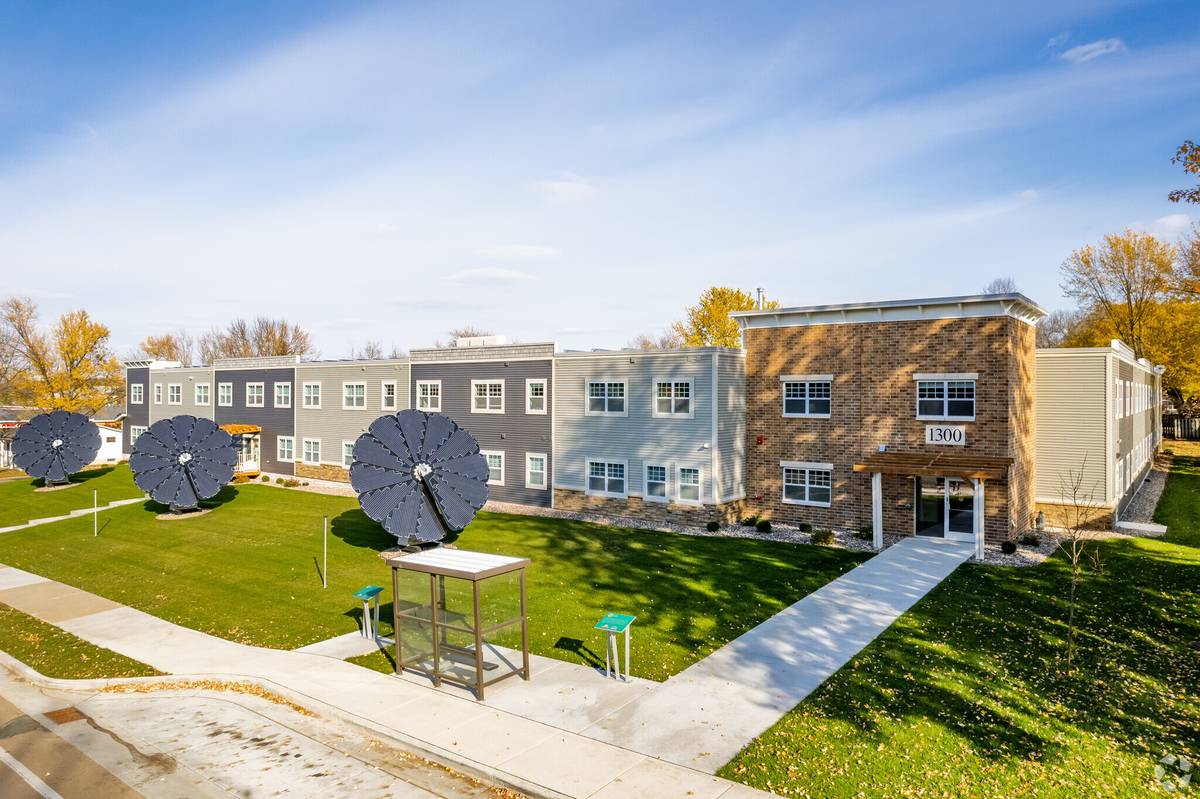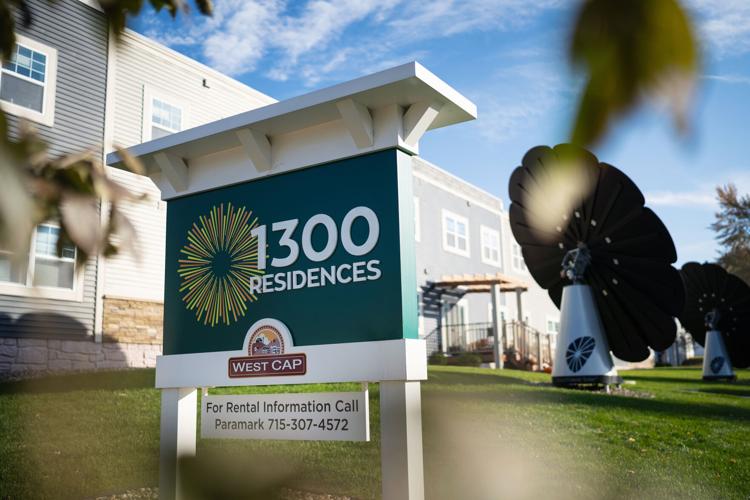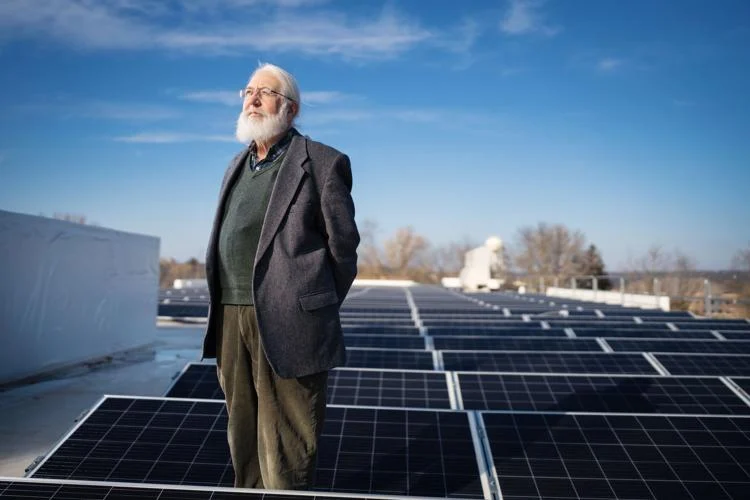Gerrard Corporation Building for a Greener Future

RIVER FALLS — Duane Church is 90 years old, has been retired since 1998, and lives on Social Security and a pension. He moved into the “1300” affordable housing complex in River Falls after his wife passed away. He was her caregiver in an assisted living facility and could no longer afford the rent.
“It was expensive over there,” Church said.
Bobbette Hull, a retired library assistant, lives on Social Security and the earnings from the sale of her small home in Shawano. She moved to River Falls in western Wisconsin, about 30 miles east of St. Paul, Minnesota, to be closer to family. She also lives at 1300 and has long wanted to access solar energy.
“The solar unit I love, because I am an eco kind of person,” Hull said.
Ray Charles Newman has lived at 1300 for two years. After spending nine years in active duty in the U.S. Navy, he now receives disability benefits from Veterans Affairs. Recently divorced, he’s found work and is saving up for a home for him and his kids.


“This place has been great to try to collect myself together and get back out there,” Newman said.
Church, Hull and Newman are residents of one of the few solar-powered, energy-efficient, affordable housing complexes in Wisconsin. 1300 Residences — named after its street address — is equipped with solar panels and electric heat pumps and is fully weatherized, making it as energy-efficient as possible. Those energy savings are passed on to residents — they never see an electric bill, saving them $90-$140 per month, depending on the size of the unit.
Low- and moderate-income Wisconsinites face some of the Midwest’s highest energy burdens, the percentage of a person’s income spent on electricity. Those same people are also least likely to be able to access costly technologies that decrease energy use, but which offer significant savings over time.
Projects like 1300 offer a silver bullet — a way to deploy renewable energy and decrease emissions in the climate crisis and at the same time cut costs for the most burdened. The reason this two-for-one affordable housing model isn’t more widespread has to do with policy.
State law doesn’t allow multi-family dwellings to use energy technologies like solar panels and electric heat pumps as one holistic system unless the building owner has an agreement with a local utility, or a waiver from the Wisconsin Public Service Commission. Because of an increase in waiver requests the last few years, the Public Service Commission has decided to reevaluate the state’s policy for rooftop solar on multi-family housing.
Without change, rooftop solar arrays for apartment buildings, condos and affordable housing projects are prohibitively expensive for developers and property owners.
Climate demands a new way of doing business
Spearheading the 1300 project in River Falls is Peter Kilde, self described as “Santa Claus with a ponytail.” He’s the executive director of West CAP, a community action agency that works to alleviate poverty through affordable housing development, homelessness intervention, food assistance and other services.
West CAP and agencies like it were formed during the 1960s’ “War on Poverty,” a set of initiatives by President Lyndon Johnson that deployed federal money to help people in low-income neighborhoods. When the next decade brought an energy crisis, West CAP provided home weatherization services and financial assistance on electricity bills.
In lieu of a sleigh, Kilde drives his baby blue VW Beetle around northwestern Wisconsin visiting West CAP projects and is only half joking when he tells people his singular hobby is “saving the world.”
In the last decade West CAP has ramped up its initiative to provide affordable housing. Kilde has long been tuned in to the threats of climate change, specifically for the world’s poor. He’s advocated for energy efficiency as an essential element to the agency’s housing projects.
“If we’re going to take climate change seriously, we have to do business differently,” Kilde said.
The partners he’s found in this quest to transform affordable housing stock are Peter and Paul Gerrard, brothers who own and operate the second-generation development and general contracting business Gerrard Corp.
When it comes to incorporating energy efficiency and renewable energy generation in affordable housing, Kilde said he told the Gerrards, “Somebody’s got to up the game here and nobody else is doing it, frankly.”
The Gerrards took on the challenge and introduced Kilde to energy efficiency technologies he’d never heard of.
Peter Gerrard said Kilde helped them understand that for new building projects, energy efficiency and on-site renewable energy are a must.
“We just took the plunge. We listened to his expert advice and now we’re doing renewable energy on every single project we build because of him,” Peter Gerrard said.
West CAP and Gerrard Corp. have partnered on 11 projects over 14 years, including the innovative 1300 housing development in River Falls.
It’s all about the metering
The factors that make 1300 unique are buried in the minutiae of how the building’s electric heating system, called a heat pump, and its solar array, are metered. In Wisconsin, rooftop solar panel owners generate energy for their own use and sell the extra back to their utility. Inversely, on a cloudy day when their panels aren’t producing at capacity, those customers buy energy from the grid to make up the difference. This system is called net metering.
If developers and owners of apartment buildings, condominiums and other multi-family dwellings want to install a rooftop solar array and make that energy available for residents, they have to install a meter for each unit.
“Solar has to have a single meter. So you would have to take a large system like this and literally carve it up into 50 individual connection points,” said Jon Richter, vice president of Energy Concepts, the solar installer behind 1300. “It’s cost-prohibitive. It doesn’t make any sense.”
Increased cost means decreased probability the component will be included in a project.
“Most developers would be very, very scared of spending even more money up front,” Paul Gerrard said.
However, the River Falls municipal utility agreed to allow the 1300 project to operate one meter for the entire housing complex. Peter Gerrard said when they approached the city, they explained the benefits of this type of project and the local utility was receptive to the somewhat unusual request after they learned more.
“We had the opportunity to really reflect on what this policy is for and is this project worth adjusting this policy? And it was, because everybody benefited from it,” said Mike Noreen, sustainability coordinator for River Falls Municipal Utilities.
Now, 580 solar panels cover the roof of 1300, producing 240 kilowatts of power and relieving residents of an electric bill. 1300 produces more solar energy than tenants can use in June, July and August — that’s when the building sends the excess back to the grid. In winter when the panels don’t produce at max capacity, the housing project draws the energy it needs to make up the difference from the utility.
“Because there’s one meter on the building, we can use these much more effective, efficient and cost-effective building-wide systems,” Kilde said.
When West CAP and Gerrard Corp. tried to recreate the success of 1300 with an Eau Claire development, the utility for that area, Xcel Energy — operating in Wisconsin as Northern States Power — cited state statute and told Richter a single meter wasn’t allowed.
“The larger utilities really frown on that,” Peter Gerrard said of single metering.
Why Big Energy is resisting
For over 100 years, utilities have operated as regulated monopolies. Wisconsin was the first state to enact this type of system, and for good reason. Electricity, water and gas are necessary for modern living. Competition in the marketplace wasn’t the most effective way to deliver utility services. In exchange for sole rights to a service area, utilities agree to be regulated and have a statutory responsibility to deliver safe, reliable and affordable energy. Large investor-owned utilities also have a fiduciary responsibility to deliver profits to their shareholders.
For a variety of reasons, Wisconsin’s largest utilities don’t seem overly enthusiastic about the growth of customer-owned solar. The energy grid is designed to take power from large central generation facilities and disperse it to customers in a service area.
As household rooftop solar grows, it’s a bit like there are mini power plants popping up all over. Those power plants cut into the profits of utilities, which are traditionally the only entities to sell electricity in their given areas. It also doesn’t change the utilities’ regulatory responsibility to ensure there is safe, reliable and affordable energy available to every customer. Customers own their own rooftop solar arrays and there is not yet a way for utilities to account for the power being produced.
“The utilities really can’t get credit for the reductions in demand that are provided by customer-owned generation,” said Corey Singletary, director of regulatory affairs at the Citizens Utility Board of Wisconsin, a nonprofit that advocates on behalf of consumers.
“The utilities don’t have direct control, at least today, over those resources. It’s also the fact that the grid is operating in a way that it wasn’t originally designed to,” Singletary said.
Historically, our energy system has been a one-way street. Utilities produce power and deliver it to customers. As more renewable sources come online, the road ahead is a bit unclear.
“In the future, we’re looking at more of a two-way flow, looking at the idea of the utility as a conductor to facilitate all of these grid services, to enable all of these technologies, while still balancing everything and making certain that it all still works.”

Potential to increase much needed affordable housing
Municipal utilities are smaller, local, community-operated service providers. Wisconsin has 81 municipal utilities that operate as nonprofits.
The slightly different operating structure of municipal utilities can allow them to be more flexible than large investor-owned companies, exemplified by the River Falls utility’s decision to make an exception for 1300.
“As a public power utility we’re trying to look out (for) what’s best for the community. We’re run by the community. We live in town,” said Noreen, the local utility’s sustainability coordinator. “There are some times where we make decisions not necessarily based on our bottom line, but what is best for this community.”
Like many cities across the nation, River Falls is facing a dearth of affordable housing. Noreen said that fact, plus the good work and reputation of West CAP and Gerrard Corp., contributed to the decision to exempt 1300 from the single-meter rule.
“It certainly helps that it’s income-qualified and it was a beautiful project in a place that was a really blighted area,” Noreen said.
After Xcel told West CAP and Gerrard Corp. that an exception to the single-meter rule wasn’t possible for the Eau Claire housing project, the developers went through the formal process of asking permission from the Wisconsin Public Service Commission to use a single meter. In August, the regulators denied the request.
Before voting, commissioners expressed their wish to approve a waiver for a solar array, but added that the law didn’t allow them to.
“I would love to wave my magic wand and grant the permanent waiver. I can’t do that based on the way that the code is written as I sit here today,” said Chairperson Rebecca Cameron Valcq.
Commissioners lauded the project’s energy-efficiency measures and said they hope more developments like this will come about in order to decarbonize the housing sector. The energy industry is transitioning to renewable sources and the technology that comes with them. Valcq noted the rules and laws the commission has to enforce haven’t kept up.
“So while it may be frustrating, I think this is a case that underscores the need for legislative change,” said Valcq.
Policy holding Wisconsin back
A significant portion of roofs in Wisconsin rest atop apartment buildings. Without changes to metering policy, they’re likely to remain void of solar arrays. The decreasing costs of solar equipment, plus government incentives, make it a cost-effective method to rapidly expand renewable energy to fight climate change. Renewable energy also can translate into lower energy bills for those who need relief most.
Heather Allen, associate director of policy for Wisconsin at Elevate, a nonprofit that retrofits affordable housing throughout Wisconsin, said her goal is to dismantle roadblocks to deploying clean energy technologies.
Speaking to her peers at a housing conference in Madison, Allen said solar funding incentives from the federal Inflation Reduction Act are an “embarrassment of riches.”
“The time is now, the money is here,” Allen said.
Developers and building owners are well-positioned to adopt sustainable practices, but Wisconsin policy could inadvertently get in their way, slowing the state’s clean-energy transition in the process.
“I think that resolving the metering question and ensuring that buildings that qualify have a simple, clear path to centralized metering will rapidly accelerate clean-energy deployment on affordable housing and rental properties across the state, which is a significant part of our housing stock,” Allen said.
Since 2017, there have been 11 individual meter waiver requests before the Wisconsin Public Service Commission, with four currently pending, according to Joe Fontaine, administrator at the commission.
In July the commission directed staff to start a process to reconsider the single-meter rule. Public Service Commission documents state the original purpose of the policy:
“To promote energy conservation, ensure that each customer is billed for their own energy consumption only, and ensure that the utility is able to disconnect the electric service to an individual unit without affecting the service of other units at a property.”
Noting an increase in waiver requests for the rule, as well as a shifting energy ecosystem, the commission is considering updating the existing provision to “support simplicity and clarity in future applications of the rule.”
Staff analysis of the rule is expected to take months with a proposal and public comment period to follow. If commissioners make changes to the policy they would have to be approved by the state Legislature and governor.

A new opportunity for affordable housing
As Minnesota’s Twin Cities grow, so do small western Wisconsin towns like River Falls. The city is predicting a 1,500 unit housing shortage by 2030 based on projected population growth.
Gerrard Corp. has done more projects in the city of Rivers Falls than any other area in the nine states where it has developments. This speaks to the company’s relationship with the municipality and the town’s commitment to sustainable development.
Jeff True is a regional manager with Paramark, the company that operates 1300.
Previously, True was a probation patrol officer in Olmsted County, Minnesota. He said until recently, affordable housing had a bad reputation. Property owners took advantage of low-income renters by not providing necessary upgrades to the buildings or even regular upkeep, True said. It had an effect on how he and other officers approached affordable housing complexes.“We didn’t enjoy going there by ourselves, not necessarily because of the dangers within those areas, just because it was so unkept and unprofessional in the way that these properties were managed,” True said.
Gerrard and West CAP properties managed by Paramark don’t look like the affordable housing projects of 10-15 years ago, True said.
“We wanted to do something different. We wanted to give individuals that maybe were a little less fortunate…an opportunity to value their apartment, value the place that they live, (and) enjoy where they live.”
He’s proud to work for a company that’s made affordable housing its niche.
“There’s such a need for it, and that’s been said now for years and years, but for whatever — oftentimes politicized reasons — there hasn’t been the public backing in a lot of communities,” True said. “Now there is because people are doing it the right way.”
Sunshine keeps the rent low
Outside of the 1300 housing project in River Falls stand three massive “solar flowers” — large metal pieces of equipment that look and act like flowers. The photovoltaic petals open up in the morning, track the sun across the sky throughout the day, and close up at night.
The solar flowers can’t be missed, attracting curiosity and inspiring interest from potential tenants.
“I want these projects to be viewed as an asset by the communities they’re in and not as a liability or as a blight or as a problem,” said Peter Kilde of West CAP.
Along with the Gerrards, Kilde is committed to changing the narrative about affordable housing. Those who live there deserve comfort and amenities, he said. Kilde is proud to brag about 1300’s heated underground parking.
“That’s not the kind of stuff you tend to find at an affordable housing project, right? I don’t even have a garage at my place,” Kilde said. “I’m out there scooping the snow off.”
After their waiver was denied in August for the Eau Claire housing project, the developers retooled. Currently, 15 wells are being drilled for geothermal heating, cooling and electricity.
“One of the things I like about them is they don’t know how to give up,” Kilde said of the Gerrard brothers. “I don’t think they’ve ever tried it. It’s just crazy.”
Although they found a suitable workaround for the Eau Claire project, they know it’s not a long term solution. Kilde and the Gerrards want to see the entire industry change so communities can access quality, energy efficient affordable housing. As vanguards of this work, they’ve slowly but surely seen other developers take note.
“When you actually see it done and built, it changes the way you perceive it and that’s really happened,” Kilde said.
Property owners can save thousands in operating costs when their buildings are sustainable. Paul Gerrard said in the first two years since 1300 was built, they’ve saved an estimated 30-40% in utility costs, and that was during some harsh winters.
“It’s Mother Nature’s free, unmetered sunshine that’s really helping stabilize the rent,” Paul Gerrard said.
When building costs and operations are decreased and controlled, there is no need to raise rents. Paul Gerrard said in the long run, this model of building is better for the owner, the tenant, and the planet.
“I love what we’re doing and I want to keep doing it, and I want to teach others how to do it.”
Original article written by Jana Rose Schleis
Read the original article HERE

0 Comments